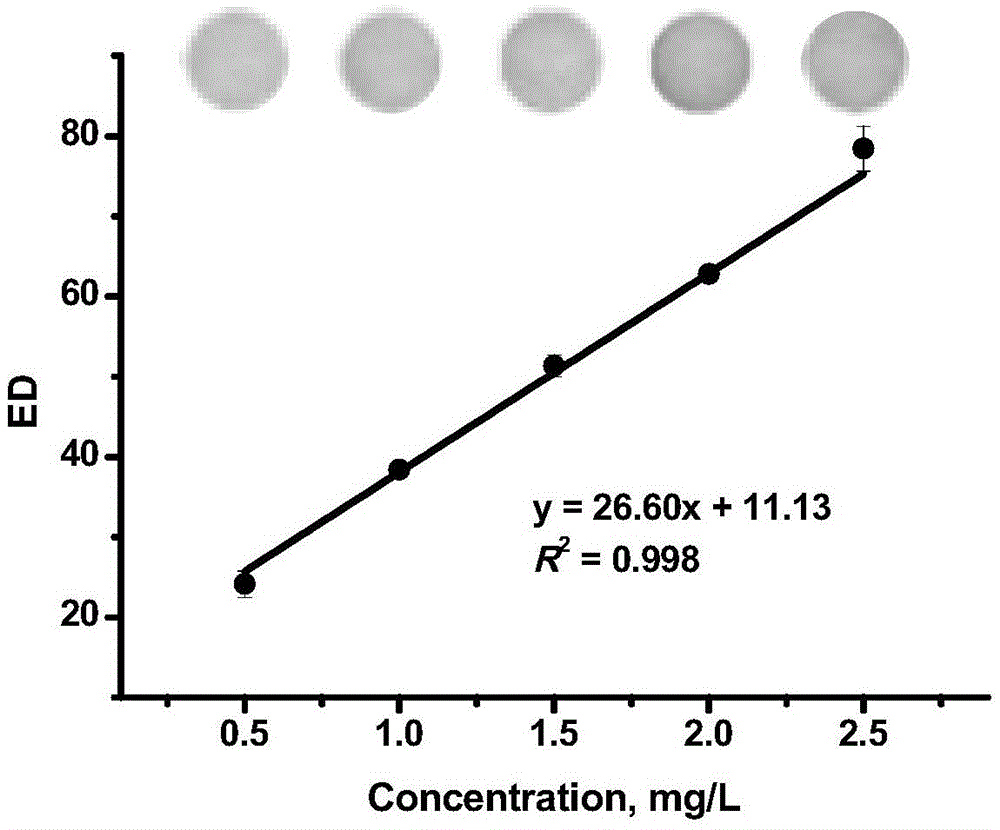Sensor for detection of dithiocarbamate pesticides and preparation and application thereof
A technology of dithiocarbamic acid and sensors, which is applied in the direction of analyzing materials through chemical reactions and observing the influence of chemical indicators on materials, etc., which can solve the problems of poor accuracy and repeatability, expensive instruments, and detection problems. Problems such as high cost, to achieve the effects of portability, improved detection sensitivity, and high selectivity
- Summary
- Abstract
- Description
- Claims
- Application Information
AI Technical Summary
Problems solved by technology
Method used
Image
Examples
Embodiment 1
[0030] Weigh 4mg neo-cuprous reagent and 8mgCuCl2 5H2O in 1mL silica gel sol gel A (tetraethoxysilane: ethylene glycol methyl ether: propylene glycol methyl ether acetate: chloroform: 0.5M hydrochloric acid: triton X- 100: water was mixed at a volume ratio of 1:4:2:0.8:0.5:0.02:0.7, hydrolyzed at 60°C for 5 hours to obtain silica gel sol-gel solution A), dissolved by ultrasonication, and then pipette 1 μL of the above solution, Dithiocarbamate pesticide sensors were prepared by drop-coating on porous filter paper with a pore size of 0.22 μm, and drying at room temperature under nitrogen protection. Firstly, the selectivity of the sensor to different kinds of pesticides was investigated. Images were recorded before and after the sensor reacted with the pesticide using a flatbed scanner. Digitalize the color of the image before and after the reaction with Photoshop software, extract the red, green and blue (RGB) channel values, and subtract the color values of each channel be...
Embodiment 2
[0032] Taking dacenolon in the dithiocarbamate insecticides as a representative, investigate the enrichment effect of the sensor prepared in Example 1, the results are as follows figure 2(a) shown. It can be seen that when 20 μL of datamonon solution containing 1 mg / L is initially dropped on the sensor, the color change is weak, and as the volume of the added pesticide increases, the color change of the sensor is gradually obvious, indicating that through enrichment, the sensor can be greatly improved. The detection sensitivity of the sensor. In order to make the operation convenient and fast, 200 μL of pesticide solution was taken as the enrichment volume in the experiment of establishing the standard concentration curve. Dilute the 0.25g / L datamon stock solution to 0.25, 0.50, 0.75, 1.00, 1.25mg / L with pH=7 ammonium acetate buffer. Take 200 μL of the above dilutions and add them dropwise to the sensor. After the solution is blotted dry by the absorbent filter paper placed...
Embodiment 3
[0034] Taking zinc zinc in the dithiocarbamate fungicides as a representative, the standard curve of the sensor prepared in Example 1 for detecting zinc zinc was investigated. The 0.25g / L Zineb stock solution was diluted to 0.5, 1.0, 1.5, 2.0, 2.5mg / L with pH=7 ammonium acetate buffer solution respectively. Take 200 μL of the above dilutions and add them dropwise to the sensor. After the solution is blotted dry by the absorbent filter paper placed under the sensor, use a flatbed scanner to record the image. The sensor enriched with 200 μL of buffer solution is used as the pre-reaction image, and the enrichment of each The sensor of zinc zinc solution is the post-reaction image, digitize the pre-reaction and post-reaction images with Photoshop software, extract the red, green and blue (RGB) channel values, and subtract the color values of each channel before and after the reaction to obtain the color change value of each channel△ R, △G, △B, and then use the formula Calculat...
PUM
 Login to View More
Login to View More Abstract
Description
Claims
Application Information
 Login to View More
Login to View More - R&D
- Intellectual Property
- Life Sciences
- Materials
- Tech Scout
- Unparalleled Data Quality
- Higher Quality Content
- 60% Fewer Hallucinations
Browse by: Latest US Patents, China's latest patents, Technical Efficacy Thesaurus, Application Domain, Technology Topic, Popular Technical Reports.
© 2025 PatSnap. All rights reserved.Legal|Privacy policy|Modern Slavery Act Transparency Statement|Sitemap|About US| Contact US: help@patsnap.com



